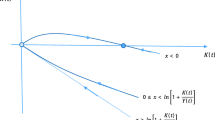Abstract
We examine the dynamics of two endogenous-growth modelsin which agents have comparison utility. In the inward-lookingeconomy, individuals care about how their current consumptioncompares with their own past consumption. In the outward-lookingeconomy, they care about how their own consumption compares withother people‘s consumption. In response to a negative shock tocapital, saving and growth will temporarily fall in both of themodels that we consider but will remain constant in a model withstandard preferences. The decline will be smaller in the outward-than in the inward-looking case, but utility will be lower inthe former case because of a negative externality.
Similar content being viewed by others
References
Abel, A. (1990). “Asset Prices Under Habit Formation and Catching Up with the Joneses,” American Economic Review40(2), 38–42.
Beckman, S. R., J. Formby, W. J. Smith, and B. Zheng. (1997). “An Experimental Examination of Pareto Efficiency, Envy, Malice and the Sentiment for Equality,” Working Paper 9703, University of Colorado–Denver, Center for Research on Economic and Social Policy.
Campbell, J.Y., and J. H. Cochrane. (1995). “By Force of Habit: A Consumption-Based Explanation of Aggregate Stock Market Behavior,” NBER Working Paper No. 4995.
Carroll, C., J. R. Overland, and D. Weil. (1997). “Saving and Growth with Habit Formation,” Mimeo, Brown University.
Carroll, C. D., and D. N. Weil. (1994). “Saving and Growth: A Reinterpretation,” Carnegie-Rochester Conference Series on Public Policy40, 133–192.
Constantinides, G. M. (1990). “Habit Formation: A Resolution of the Equity Premium Puzzle,” Journal of Political Economy98, 519–543.
Deaton, A. S., and C. H. Paxson. (1992). “Saving, Growth, and Aging in Taiwan. In D. A. Wise (ed.), Studies in the Economics of Aging. Chicago: University of Chicago Press.
Duesenberry, J. S. (1949). Income, Saving, and the Theory of Consumer Behavior. Cambridge, MA: Harvard University Press.
Dynan, K. E. (1993). “Habit Formation in Consumer Preferences: Evidence from Panel Data,” Economic Activity Working Paper Number 143, Board of Governors of the Federal Reserve System.
Frank, R. H. (1985). On Choosing the Right Pond: Human Behavior and the Quest for Status. New York: Oxford University Press.
Gali, J. (1994). “Keeping Up with the Joneses: Consumption Externalities, Portfolio Choice, and Asset Prices,” Journal of Money, Credit, and Banking26(1), 1–8.
Kapteyn, A., T. J. Wansbeek, and J. Buyze. (1980). “The Dynamics of Preference Formation,” Journal of Economic Behavior and Organization1, 123–157.
Lowenstein, G., and N. Sicherman. (1991). “Do Workers Prefer Increasing Wage Profiles?,” Journal of Labor Economics9(1), 67–84.
Lucas, R. E. J. (1988). “On the Mechanics of Economic Development,” Journal of Monetary Economics22(1), 3–42.
Overland, J. R. (1997). “Optimal Saving with Stochastic Income and Habit Formation,” Working Paper 9704, University of Colorado–Denver, Center for Research on Economic and Social Policy.
Parente, S. L., and E. C. Prescott. (1994). “Barriers to Technology Adoption and Development,” Journal of Political Economy102(2), 298–321.
Pigou, A. C. (1903). “Some Remarks on Utility,” Economic Journal, 58–68.
Pollack, R. A. (1978). “Endogenous Tastes in Demand and Welfare Analysis,” American Economic Review68, 374–379.
Rebelo, S. T. (1991). “Long-Run Policy Analysis and Long-Run Growth,” Journal of Political Economy99(3), 500–521.
Runciman, W. G. (1966). Relative Deprivation and Social Justice: A Study of Attitudes to Social Inequality in Twentieth-Century England. Berkeley: University of California Press.
Ryder, Jr., H., and G. Heal. (1973). “Optimal Growth with Intertemporally Dependent Preferences,” Review of Economic Studies40, 1–31.
Sen, A. (1983). “Poor, Relatively Speaking,” Oxford Economic Papers35, 153–169.
Smith, A. (1776). “An Inquiry into the Nature and Causes of the Wealth of Nations.” In E. Cannan (ed.), The Wealth of Nations: The Cannan Edition. New York: Modern Library, 1937.
Van de Stadt, H., A. Kapteyn, and S. van de Geer. (1985). “The Impact of Changes in Income and Family Composition on Subjective Well-Being,” Review of Economics and Statistics67(2), 179–187.
Veblen, T. (1899). The Theory of the Leisure Class. New York: Modern Library.
Author information
Authors and Affiliations
Rights and permissions
About this article
Cite this article
Carroll, C.D., Overland, J. & Weil, D.N. Comparison Utility in a Growth Model. Journal of Economic Growth 2, 339–367 (1997). https://doi.org/10.1023/A:1009740920294
Issue Date:
DOI: https://doi.org/10.1023/A:1009740920294



